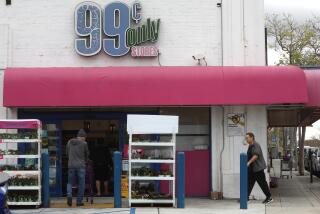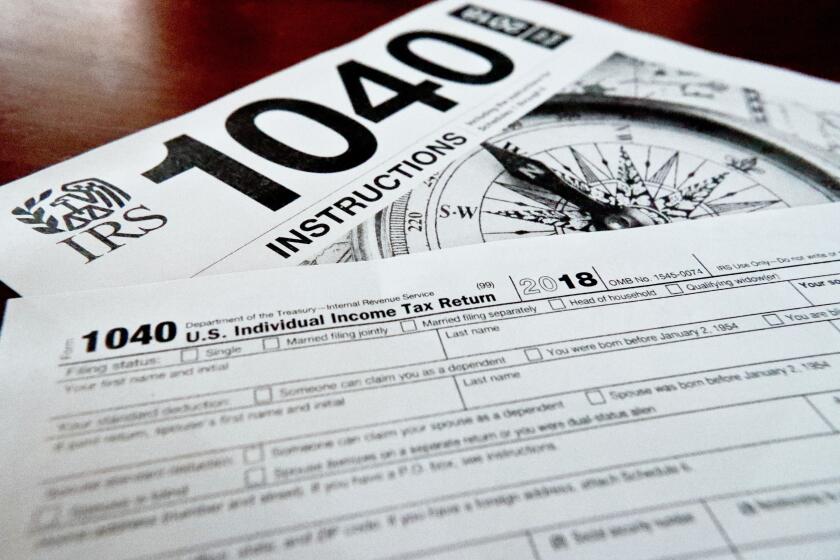Price Pfister Taps New Markets : Faucets: The Pacoima company says it is improving its position despite the overall drop in sales of plumbing products. Its competitors disagree.
- Share via
After several ownership changes in the 1980s, faucet maker Price Pfister Inc. seems securely nestled in the fold of its owner, Black & Decker Corp., the power-tools and household-products giant.
But whether Black & Decker can help Pacoima-based Price Pfister climb above its perennial No. 3 spot in the U. S. faucet market is an open question.
The added distribution channels provided by Black & Decker, which had 1991 sales of $4.6 billion, has now enabled 82-year-old Price Pfister to expand beyond its traditional Western base and peddle its faucets, valves and other fittings nationwide.
Black & Decker acquired Price Pfister in 1989 when it bought Price Pfister’s old parent, Emhart Corp., for $2.8 billion, then installed its top U. S. sales executive, Michael Convey, as president of Price Pfister. He brought with him not only years of experience in marketing consumer products, but also millions of Black & Decker dollars for upgrading Price Pfister’s plant and equipment.
Never mind that Convey’s knowledge of faucets initially was “zippo, nothing,” he conceded, “although plumbing products are sold through a lot of the similar channels” as power tools, door locks and other Black & Decker items.
Plumbing products are also in less demand lately, with overall U. S. sales dropping the past two years because of the recession and a falloff in home construction. That’s forced Price Pfister and its rivals to shift their focus to the home-improvement market, where “you can still dramatically change the look of your bathroom with a faucet without having to tear out your sink,” said Doug Martinez, the 29-year-old marketing director of Price Pfister, whose faucets range in price from $12 to $375.
Despite those obstacles, Price Pfister claims that Black & Decker has helped it grow faster in recent years than its two larger rivals, the Delta/Peerless group of Masco Corp. and the Moen group of American Brands Inc.
“We have been the fastest-growing in market share, sales and definitely profitability in the last two to three years” Martinez said.
According to its rivals, however, Price Pfister is all wet.
Raymond F. Kennedy, president of Masco’s building products group, said: “We and Moen have grown better than Price Pfister the last two years. And I don’t believe there’s that much Black & Decker is going to change in Price Pfister’s sales level.”
Kennedy estimates that Price Pfister’s share of the U. S. market is 10% to 15%, while Masco leads with 33% and Moen has 20% to 22% of the business.
Moen, which is part of American Brands’ MasterBrand Industries Inc. unit, claims that its market share is actually closer to 30%. And although he won’t comment specifically on Price Pfister, Randall W. Larrimore, MasterBrand’s president, said: “Moen has seen substantial market share growth over the last couple of years in a market that’s been declining.”
Translation: Price Pfister isn’t all that stronger a rival since Black & Decker arrived.
Who’s right? Well, the U. S. faucet market can be as murky as rusty tap water to anyone trying to dissect it.
The Plumbing Manufacturers Institute, a trade group, estimates that U. S. sales of faucets and related fittings last year totaled 33 million units, down 5% from the prior year. The group does not provide dollar volume, but Kennedy estimated industrywide sales at more than $1 billion a year.
But because Price Pfister, Delta/Peerless and Moen are all owned by larger parent companies, their individual financial results are not regularly published. Kennedy said Masco’s faucet sales totaled $457 million last year; Moen’s Larrimore will say only that Moen’s sales are higher than $300 million.
Price Pfister also won’t divulge its sales, other than to say they’re higher than the $117 million that it reported for 1987, its last year as a publicly held company.
Black & Decker does break out annual sales for its “plumbing products” group. But the company won’t specify Price Pfister’s contribution except to say that Price Pfister accounts for most of the group’s business. In any case, the plumbing products group’s sales in 1991 fell 5%, to $148 million from $156 million the previous year, and Black & Decker spokeswoman Barbara Lucas said Price Pfister’s sales alone also declined.
If one extrapolates from Black & Decker’s numbers, they would show that the plumbing products group’s pretax earnings would be in the neighborhood of $12 million to $16 million a year, for an 8% to 10% pretax profit margin--not bad for what is largely a commodity business. Martinez would say only that those numbers “are in the ballpark.”
No one disputes that Price Pfister grew nicely in the 1980s by filling consumers’ growing demand for decorative faucets and by instilling increased brand loyalty through a clever marketing campaign with the slogan “The Pfabulous Pfaucet With the Pfunny Name.”
“We really moved ourselves away from the pack,” Martinez said.
It’s also noteworthy that Price Pfister maintained its growth despite having five different owners in the past 23 years. The key was that although Price Pfister was repeatedly bought and sold, its management stayed largely intact.
Peter S. Gold was chief executive of Price Pfister through the 1980s and stayed on one year under Black & Decker’s reign even though in 1988 he had personally reaped about $60 million when Price Pfister was bought by Emhart for $215 million. He retired in 1990 at age 65.
In succeeding Gold, Convey beefed up the company’s quality controls, enhanced its manufacturing efficiency and upgraded the training of its employees.
“Our capital investment at Price Pfister is a quantum leap higher than it was two years ago,” said Convey, 51. He will describe the amount only as being “in the millions of dollars.”
Yet Price Pfister’s quality also comes into question by Masco’s Kennedy, who noted that most of Price Pfister’s products are made from pouring molten brass into castings at its Pacoima foundry.
“I’m not suggesting they don’t make a good faucet,” Kennedy said. But he said the process makes it “difficult to maintain exact quality” and can create “porousness in the castings, little pinholes you don’t always see that can cause leaking and pitting.” Masco and Moen avoid that threat by making their faucets from cutting solid brass bars, he said.
Martinez said Price Pfister’s quality and product testing is “superior.” Pouring brass also enables the company to “form and shape faucets in a more artistic way,” he said, “and we’ve always demonstrated that a key part of our competitive edge is in the beauty of the products.”
Convey has also trimmed Price Pfister’s work force by about 20% to its present 1,800 employees, he said, a step that included an undisclosed number of layoffs. But Price Pfister also had to contend with an economic recession that has battered one of its key markets--the new housing industry.
“We have not grown as rapidly in 1990-91 as we grew in 1985-87, but the market didn’t either,” Convey said. “That’s why we’re comfortable that even though the market has softened, we’ve done as well or better in taking market share” from competitors, he said.
Martinez noted that in the last five years, “we’ve skewed our sales” away from the slumping new housing industry to the retail home-improvement market, where the growing popularity of such chains as Home Depot has given Price Pfister and its competitors a strong new area of distribution.
Lately, Convey said Price Pfister is “starting to see the mix turn back the other way” to the housing construction market, “which to us is a strong signal of economic improvement.”
In the meantime, Price Pfister also plans to further expand its product line, providing towel racks and other bathroom/kitchen accessories with its faucets. Martinez said, “We will probably make more of an investment in new product development in the 1991-94 time frame than in the last 30 years of the company.”
Will that finally lift Price Pfister out of its third-place slot? Convey isn’t making predictions, but he does claim one success: “We are not No. 3 when it comes to people recognizing our name.”
A Price Pfister Chronology
Price Pfister Inc., a Pacoima-based maker of faucets and other plumbing products, has undergone several ownership changes over the past 80 years. Here are key dates in its history:
* 1910--Company founded by Emil Price and William Pfister to make gasoline generators.
* 1912--Begins making garden faucets.
* 1946--Expands into home faucets.
* 1969--Company is purchased by Norris Industries Inc. in Long Beach.
* 1981--Norris Industries, a diversified manufacturer, is bought by investment banking firm Kohlberg Kravis Roberts & Co. for $420 million.
* 1983--Three Price Pfister executives buy Price Pfister from Norris, now called NI Industries, for $35 million.
* 1987--Price Pfister sells 18% of company in public stock offering.
* 1988--Price Pfister is bought by Emhart Corp. for $215 million.
* 1989--Emhart (and Price Pfister) is bought by Black & Decker Corp. for $2.8 billion.
More to Read
Inside the business of entertainment
The Wide Shot brings you news, analysis and insights on everything from streaming wars to production — and what it all means for the future.
You may occasionally receive promotional content from the Los Angeles Times.











